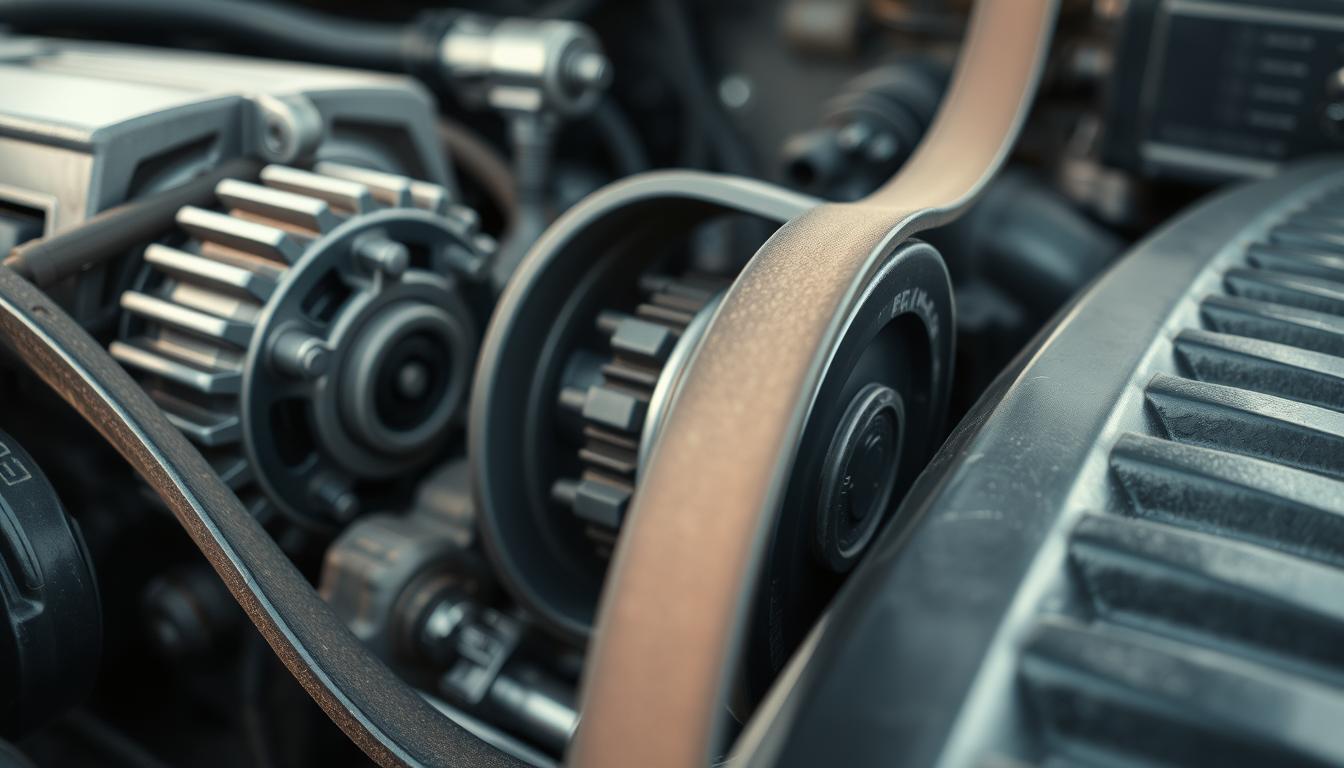Did you know nearly one in five drivers hear a sharp noise at a cold start that hints at a bigger issue under the hood.
We’ll explain why that sharp squeal happens and how a belt grips pulleys—so your car stops screaming and you leave calm and confident.
Quick, simple checks show the usual suspects: glazing, contamination, misalignment, weak tension, or a sudden electrical load after a night’s rest.
We outline the parts involved—the serpentine, tensioner, idler, and accessory pulleys—so you know what to look for before you start.
Follow our plan: diagnose first, then fix. We point to when a clean will help and when replacement saves time and money. For visual help, we note where a short video and a phone light make inspection easy and clear.
Key Takeaways
- Identify common causes quickly—glaze, oil, alignment, or weak tension.
- Know the parts: serpentine, tensioner, idler, and accessory pulleys.
- Simple driveway checks often reveal the true problem.
- Cleaning can cure some noise; replacement prevents repeat issues.
- Use a short video or phone light to document findings for clarity.
Diagnose the noise at cold start: quick checks before you crank
Before you turn the key, pop the hood and look closely. A shine on the belt, frayed edges, or rubber dust near pulleys is a clear sign of slip or misalignment. These simple sights tell us a lot fast.
Differentiate belt squeal from other engine noises
A high, steady squeal usually means the belt is slipping. A quick chirp points to a misaligned rib. A growl or grind often comes from a bad pulley bearing, not the drive itself.
Safety first: inspect with the engine off and accessories disabled
- Spin idler and tensioner by hand—feel for roughness or wobble.
- Use a flashlight to check pulley faces and belt tracking for crooked alignment.
- Smell and check for oil or coolant on the path—contamination cuts grip.
- Disconnect accessories, then start briefly to see if the noise changes.
- Record a short video of the start so we can review views and pitch later.
| Sound | Likely cause | Quick test |
|---|---|---|
| High steady squeal | Slipping belt | Press mid-span; low tension = slip |
| Rapid chirp | Misaligned rib | Check pulley faces and tracking |
| Grinding/growl | Pulley bearing failure | Spin pulleys by hand for roughness |
| Intermittent hum | Accessory load spike | Disable A/C and retest |
Fixing a squealing belt during morning startup: causes and step-by-step solutions

A focused inspection and a few targeted fixes usually silence the problem and get your car to run like new. We walk through common causes and clear action steps so you can test and repair with confidence.
Glazed or worn rubber: signs and replacement
Shiny ribs, cracks, or frayed edges mean the rubber lost grip. Replace a glazed or cracked belt with the correct length and rib count, follow the under-hood routing diagram, and set tension to spec.
Automatic tensioner problems
With the belt off, sweep the tensioner through its range. Sticky travel or weak return points to failure—swap the unit and the noise will often stop within a day.
Misalignment and pulley checks
Spin idlers and accessories by hand. Any wobble or roughness means bearing replacement or bracket straightening. Make pulley faces coplanar so the belt tracks true and the belt squeak ends.
Contamination and cold-start loads
Degrease grooves with a nylon brush and brake cleaner after fixing leaks from valve covers or pumps. If the battery forces the alternator to work max output at a cold start, load-test the battery and inspect the alternator and A/C clutch.
Final check: start the engine with accessories off, then add loads one by one. If quiet through each step, your engine will run like it should and your car will be ready for the day.
Prevent belt squeak long term so your car runs like new

We follow a few simple habits that help the engine run like new and cut down repeat noise. Small, regular steps stop tiny faults from turning into big problems.
Maintenance intervals: inspection cadence by months and miles
Inspect every 6 months or every 6,000–10,000 miles. Look for micro-cracks, glazing, and rib wear. Replace the belt near 60,000–100,000 miles or per your manual.
Consider swapping the tensioner at the same time. That pairing keeps alignment stable and prevents common failures.
Best practices for cold mornings: warm-up minutes, accessory load, and belt care
On freezing days, give the engine a gentle warm-up for a few minutes before turning on high electrical loads. Easing in accessories reduces alternator surge and keeps slipping to a minimum.
- Wipe pulley grooves during oil changes to catch seepage early—oil contamination ruins grip.
- After heavy rain or a car wash, idle briefly so moisture clears and a temporary squeaking stops.
- Log quick notes every few weeks or months and save a short video as a baseline for future views.
Seasonal checklist: belt, tensioner, pulleys, battery. These simple checks make the engine run predictably and help your car run like new.
Conclusion
Close with a practical plan—inspect, fix, and verify—so each crank is calmer.
We recommend a simple routine: check for glazing and leaks, align pulleys, then replace worn parts. Test with accessories off, add loads slowly, and listen for any remaining squeal.
Keep brief notes by weeks and months—record weather, what you changed, and short video views of the sound. Those views help spot a recurring sign before it costs more time or parts.
Do maintenance on schedule and your drive will run quieter for months. If you’re unsure, a quick shop visit can confirm tension, measure wear, and save repeat trips.
FAQ
How can we quickly tell if the noise at cold start is a belt or something else?
Listen for a high-pitched squeal right when the engine cranks and for the first few seconds of idle. Belts make a sharp, continuous noise that changes with throttle. Alternator bearings or a failing pulley often add grinding or rattle. We recommend a quick visual check of belts and pulleys with the engine off and accessories disabled to narrow it down.
What safety steps should we take before inspecting under the hood?
Always park on level ground, set the parking brake, and switch off the engine. Disconnect the negative battery terminal when working near belts or electrical components. Allow the engine to cool, wear gloves and eye protection, and keep loose clothing and jewelry away from moving parts.
What visual signs show a glazed or worn drive belt and when should we replace it?
Look for shiny, hard surfaces, cracks across ribs, fraying, or missing chunks. If the belt looks glazed or brittle, or if it’s more than the manufacturer’s recommended interval, replace it. A suspect belt can slip and cause noise or poor accessory performance.
How do we test if the automatic tensioner is failing or too loose?
With the engine off, push on the belt span to check for excessive play. A weak tensioner may allow noticeable movement or make a clunk when the engine starts. If the tensioner pulley wobbles or shows axle play, replace the tensioner assembly rather than just re-tensioning.
How can we spot pulley misalignment and correct it?
Inspect pulleys for wobble or side-to-side movement and check that belts sit square in pulley grooves. Use a straightedge or string across pulley faces for alignment. Misaligned accessories often need bracket adjustment or replacement of worn bearings to restore proper tracking.
Could oil or coolant on pulleys cause the noise and how do we fix contamination?
Yes — fluid on a pulley or belt causes slipping and a loud high-pitch noise. Clean all affected pulleys with a suitable degreaser, replace the contaminated belt, and repair the leaking seal or hose to prevent recurrence.
What are cold-start load spikes and which components should we check?
At cold start the alternator, A/C clutch, and other accessories can draw extra torque, increasing belt load and noise. Test the battery condition, alternator output, and A/C clutch operation. Weak batteries or heavy accessory loads can make belts slip until the engine warms up.
How often should we inspect and replace drive belts to keep the car running like new?
Check belts at least every 6 months or during every oil change. Most manufacturers recommend replacement between 60,000 and 100,000 miles, depending on material and driving conditions. If you see wear or hear recurring noise, replace sooner.
What short practices help on cold mornings to reduce belt noise?
Minimize accessory load for the first minute — avoid heavy A/C or electrical draws. Let the engine idle a short time to build oil pressure and warm the belt. Regularly clean pulleys and keep fluids in good condition to reduce contamination-related slips.
If noise returns after repairs, what should we do next?
Re-check belt tension, pulley alignment, and for any lingering contamination. Inspect accessory bearings (alternator, idler, tensioner) and the tensioner spring. If problems persist, consult a licensed technician — persistent noise can signal a failing accessory or incorrect installation.
Recent Posts
Wondering how to clean piano black car interior surfaces without leaving streaks? Well show you how to get that showroom shine back with just a few simple steps.
If youre staring up at a drooping piece of fabric, dont fret—learning **how to fix car interior roof** sagging is surprisingly simple and a fantastic way to refresh your ride without a hefty repair...


